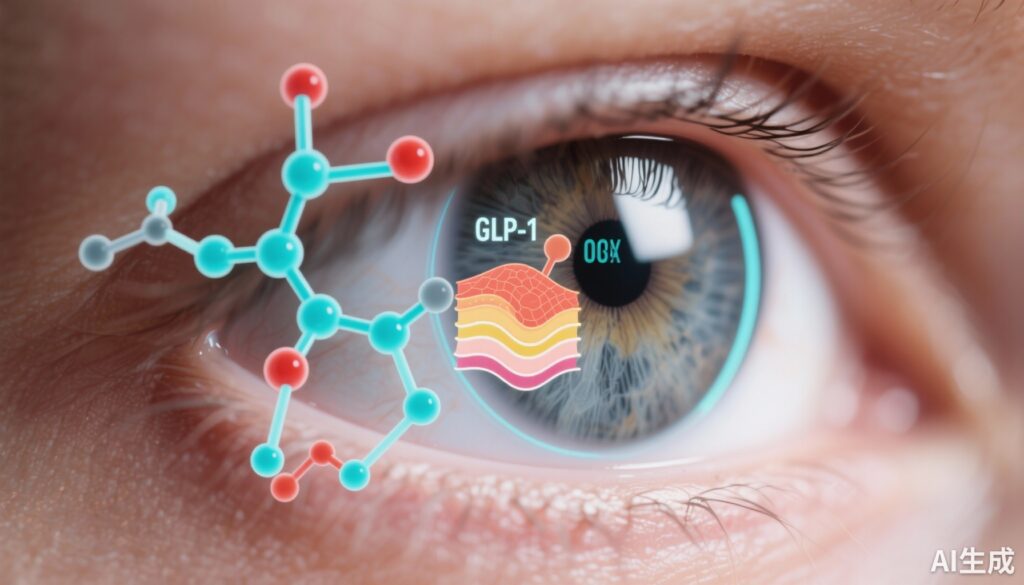Highlight
- Use of glucagon-like peptide-1 receptor agonists (GLP-1RAs) in obese, nondiabetic adults is associated with a markedly reduced risk of developing nonexudative age-related macular degeneration (AMD).
- The protective effect of GLP-1RAs persists at 5, 7, and 10 years of follow-up compared to other weight-loss drugs (OWLDs).
- GLP-1RA treatment does not appear to influence progression from nonexudative to exudative AMD.
- Findings highlight potential ocular benefits of GLP-1RAs outside diabetes and support further prospective trials in diverse populations.
Study Background
Age-related macular degeneration (AMD) is a leading cause of vision loss among older adults worldwide, characterized by progressive degeneration of the central retina. There are two main forms: nonexudative (dry) AMD and exudative (wet) AMD, with the latter associated with neovascularization and more rapid vision decline. Given the aging population and the growing prevalence of obesity, identifying modifiable factors and pharmacologic interventions to prevent AMD onset or progression is an important public health goal.
Glucagon-like peptide-1 receptor agonists (GLP-1RAs), developed primarily for diabetes management, have gained widespread use as weight-loss agents in individuals with obesity, including those without diabetes. Prior observational studies suggest GLP-1RA use may lower AMD risk in patients with diabetes, possibly through neuroprotective, anti-inflammatory, or vascular effects on the retina. However, the ocular effects of GLP-1RAs in nondiabetic populations remain underexplored. This knowledge gap hampers clinical decision-making and limits understanding of GLP-1RA’s potential beyond glycemic control.
Study Design
This retrospective cohort study utilized electronic health records from the multicenter TriNetX Global Collaborative Network, encompassing data from January 2004 through July 2025. Inclusion criteria targeted adults aged 55 years or older diagnosed with overweight or obesity (without diabetes) who were prescribed either GLP-1RAs (liraglutide or semaglutide) or other weight-loss drugs (OWLDs) including lorcaserin, sibutramine, setmelanotide, fenfluramine, mazindol, orlistat, phentermine, and diethylpropion.
Two cohorts were analyzed:
1. Primary analysis cohort excluded patients with preexisting nonexudative AMD to assess incident cases.
2. Secondary analysis included patients with preexisting nonexudative AMD but excluded those with exudative AMD, to evaluate progression to exudative AMD.
Propensity score matching (1:1) balanced demographics and comorbidities, yielding well-matched cohorts of 45,704 patients each in the primary analysis. Outcomes assessed included development of nonexudative AMD at 5, 7, and 10 years, and progression to exudative AMD at 10 years. Risk ratios (RRs) with 95% confidence intervals (CIs) quantified comparative risks.
Key Findings
Out of 91,408 patients initially included, after matching the GLP-1RA and OWLD cohorts were highly balanced:
- Approximately 78.2% female in both groups.
- Mean age ~61 years.
- Similar baseline comorbidities and demographics.
Major findings from the primary analysis showed a significant and sustained reduction in incident nonexudative AMD risk among GLP-1RA users compared to OWLD users:
– 5 years: RR 0.16 (95% CI, 0.10–0.28; P < .001)
– 7 years: RR 0.13 (95% CI, 0.08–0.22; P < .001)
– 10 years: RR 0.09 (95% CI, 0.05–0.16; P < .001)
This translates into an approximately 84% to 91% lower risk over 5 to 10 years among GLP-1RA users.
The secondary analysis assessing progression from nonexudative to exudative AMD at 10 years found no significant difference between GLP-1RA and OWLD groups, suggesting GLP-1RAs may not influence later-stage neovascular AMD development.
No unexpected safety concerns related to ocular outcomes were reported in either group. However, the retrospective nature limits detailed safety profiling specific to eye health.
Expert Commentary
These findings represent a compelling signal that GLP-1 receptor agonists may confer protective effects against the development of nonexudative AMD in obese individuals without diabetes. The large sample size and rigorous propensity matching strengthen the validity of these observations. Potential mechanisms include GLP-1RA-mediated anti-inflammatory actions, improved retinal metabolism, and vascular modulation, consistent with prior preclinical and diabetic patient studies.
Nevertheless, the retrospective design carries inherent limitations such as residual confounding and reliance on diagnostic coding accuracy. Lack of detailed ophthalmologic imaging data limits granular phenotyping. Furthermore, data on adherence, dosage, and duration of GLP-1RA therapy were not deeply explored. The absence of effect on progression to exudative AMD underscores distinct pathophysiological drivers between AMD stages.
Future randomized controlled trials should examine GLP-1RAs as preventive agents for AMD, ideally integrating multimodal retinal imaging and functional assessments to validate these promising epidemiologic findings. Expanding research to diverse ethnic groups and examining potential gene-drug interactions will also be pivotal.
Conclusion
This large real-world cohort study provides preliminary evidence that GLP-1 receptor agonists significantly reduce the risk of developing nonexudative age-related macular degeneration among obese adults without diabetes, while showing no impact on progression to the exudative form of AMD. These findings broaden the scope of ocular benefits potentially attributable to GLP-1RA therapy beyond glycemic management and propose a novel avenue for AMD prevention. Clinicians should consider this emerging evidence when managing patients with obesity, though prospective trials are warranted to confirm causality and clarify mechanistic underpinnings.
Funding and Clinical Trial Information
No funding disclosures were mentioned in the study. Given the retrospective observational design using existing electronic health data, no clinical trial registration applies.
References
Ahuja AS, Paredes AA 3rd, Young BK. Glucagon-Like Peptide-1 Receptor Agonists and Age-Related Macular Degeneration. JAMA Ophthalmol. 2025 Oct 23:e253821. doi: 10.1001/jamaophthalmol.2025.3821. Epub ahead of print. PMID: 41129133; PMCID: PMC12550735.
Additional references for contextual understanding:
1. Klein R, Chou CF, Klein BEK, et al. Prevalence of Age-related Macular Degeneration in the US Population. Arch Ophthalmol. 2011;129(1):75-80.
2. Drucker DJ. Mechanisms of Action and Therapeutic Application of Glucagon-like Peptide-1. Cell Metab. 2018;27(4):740-756.
3. Donath MY. Targeting Inflammation in the Treatment of Type 2 Diabetes: Time to Start. Nat Rev Drug Discov. 2014;13(6):465-476.



